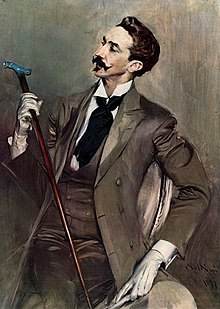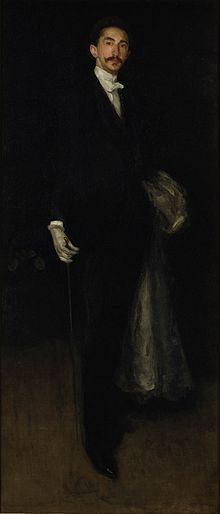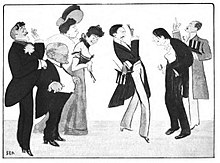sport.wikisort.org - Athlete
Marie Joseph Robert Anatole, Comte de Montesquiou-Fézensac (7 March 1855, Paris – 11 December 1921, Menton), was a French aesthete, Symbolist poet, painter, art collector, art interpreter, and dandy. He is reputed to have been the inspiration both for Jean des Esseintes in Joris-Karl Huysmans' À rebours (1884) and, most famously, for the Baron de Charlus in Marcel Proust's À la recherche du temps perdu (1913–1927).[1] Some believe that he may even have been used by Oscar Wilde in The Picture of Dorian Gray.[2]
Robert de Montesquiou | |
|---|---|
| Comte de Montesquiou-Fézensac | |
 Portrait by Giovanni Boldini, 1897 | |
| Born | Marie Joseph Robert Anatole de Montesquiou-Fézensac 7 March 1855 |
| Died | 11 December 1921 (aged 66) |
| Noble family | Montesquiou |
| Father | Thierry, Comte de Montesquiou-Fézensac |
| Mother | Pauline Duroux |
| Occupation |
|
Biography


Robert de Montesquiou was a scion of the French Montesquiou-Fézensac family. His paternal grandfather was Count Anatole de Montesquiou-Fézensac (1788–1878), aide-de-camp to Napoleon and grand officer of the Légion d'honneur; his father was Anatole's third son, Thierry, who married Pauline Duroux, an orphan, in 1841. With his wife's dowry, Thierry bought a Charnizay manor, built a mansion in Paris, and was elected Vice-President of the Jockey Club. He was a successful stockbroker who left a substantial fortune. Robert was the last of his parents' children, after brothers Gontran and Aymery, and sister Élise.[1] His cousin, Élisabeth, Countess Greffulhe (1860–1952), was one of Marcel Proust's models for the Duchess of Guermantes in À la recherche du temps perdu.[3]
Montesquiou had a strong influence on Émile Gallé (1846–1904), a glass artist with whom he collaborated, and from whom he commissioned major works, and from whom he received hundreds of adulatory letters. He also wrote the verses found in the optional choral parts of Gabriel Fauré's Pavane.
The portrait Arrangement in Black and Gold: Comte Robert de Montesquiou-Fezensac was painted in 1891–92 by Montesquiou's close friend, and model for many of his eccentric mannerisms, James Whistler. The French artist Antonio de La Gandara (1861–1917) produced several portraits of Montesquiou.
One author provides the following verbal portrait of Montesquiou: "Tall, black-haired, Kaiser-moustached, he cackled and screamed in weird attitudes, giggling in high soprano, hiding his black teeth behind an exquisitely gloved hand—the poseur absolute. Montesquiou's homosexual tendencies were patently obvious, but he may in fact have lived a chaste life. He had no affairs with women, although in 1876 he reportedly once slept with the great actress Sarah Bernhardt, after which he vomited for twenty-four hours. (She remained a great friend.)"[4]

Montesquiou had social relationships and collaborations with many celebrities of the fin de siècle period, including Alphonse Daudet (1840–1897), Edmond de Goncourt (1822–1896), Eleonora Duse (1858–1924), Sarah Bernhardt (1844–1923), Gabriele d'Annunzio (1863–1938), Anna de Noailles (1876–1933), Marthe Bibesco (1886–1973), Luisa Casati (1881–1957), Maurice Barrès (1862–1923), Franca Florio (1873-1950), and Samuel Jean Pozzi (1846-1918).[1][5]
In 1885, he began a close long-term relationship with Gabriel Yturri (March 12, 1860 – July 6, 1905), a South American immigrant from Tucumán, Argentina who became his secretary, companion and lover. After Yturri died of diabetes, Henri Pinard replaced him as secretary in 1908 and eventually inherited Montesquiou's much reduced fortune. Montesquiou and Yturri are buried alongside each other at Cimetière des Gonards in Versailles, Île-de-France, France.
He finished third in the hacks and hunter combined event at the 1900 Summer Olympics.[6][7]
An Adventure
In his biography, Philippe Jullian proposes that the Moberly–Jourdain incident in 1901, in which Charlotte Anne Moberly and Eleanor Jourdain claimed to experience time travel in the grounds of the Petit Trianon, is explained by their stumbling into a rehearsal of one of Montesquiou's Tableaux Vivants, with his friends (one possibly transvestite) dressed in period costume. Joan Evans, who owned the copyright to An Adventure (1911), Moberly and Jourdain's account of their experiences, accepted this solution and forbade any further editions.
Works
Montesquiou's poetry has been called untranslatable,[8] and it was poorly received by critics at the time.[1] "[I]n tune with the majority of Montesquiou's critics was the opinion of Paul Morand, who wrote:"
Montesquiou has polished a thousand sonnets with a hand jewelled with black pearls and will leave behind nothing but a few modern-style curiosities and some imitations of Mallarmé written in red ink and sprinkled with gold dust. A personality of the most curious, because entirely phony, from a period of dazzling falsifiers and of pious and impious lies. He will survive thanks only to the des Esseintes of Huysmans and the Baron de Charlus of Proust. Montesquiou was right to frequent men of letters.[9]
As for his paintings, he showed them "only to a few individuals, but after his death over a hundred of them were exhibited in 1923 at the Galeries Georges Petit...."[10] "Montesquiou's work has been offered at auction multiple times, with realized prices ranging from 325 USD to 2,520 USD...."[11]
As for his art interpretation (he distinguished art interpreters from art critics), he excelled "perhaps far beyond his accomplishments as a poet.... This art interpreter published books, catalogues, articles, and extensive passages in his memoirs devoted to [numerous] painters, sculptors, and craftsmen...."[12]
Poetry
- Les Chauves-Souris, Clairs obscurs (Richard, privately published in 1892, commercially published in 1893; illustrated by Madeleine Lemaire, James McNeill Whistler and Antonio de La Gandara).
- Le Chef des odeurs suaves, Floréal extrait (Richard, 1893)
- Le Parcours du rêve au souvenir (Charpentier et Fasquelle, 1895)
- Les Hortensias bleus (Charpentier et Fasquelle, 1896)
- Les Perles rouges : 93 sonnets historiques (Charpentier et Fasquelle, 1899)
- Les Paons (Charpentier et Fasquelle, 1901)
- Prières de tous : Huit dizaines d'un chapelet rythmique (Maison du Livre, 1902)
- Calendrier Robert de Montesquiou pour 1903
- Calendrier Robert de Montesquiou 1904
- Passiflora (L'Abbaye, 1907)
- Les Paroles diaprées, cent dédicaces (Richard, 1910)
- Les Paroles diaprées, nouvelle série de dédicaces (Richard, 1912)
- Les Offrandes blessées : élégies guerrières (Sansot, 1915)
- Nouvelles Offrandes blessées (Maison du Livre, 1915)
- Offrande coloniale (1915)
- Sabliers et lacrymatoires : élégies guerrières et humaines (Sansot, 1917)
- Un moment du pleur éternel : offrandes innommées (Sansot, 1919)
- Les Quarante bergères : Portraits satiriques..., with a frontispiece by Aubrey Beardsley (Librairie de France, 1925)
Essays
- Félicité : étude sur la poësie de Marceline Desbordes-Valmore, suivie d'un essai de classification de ses motifs d'inspiration (Lemerre, 1894)
- Roseaux pensants (Charpentier et Fasquelle, 1897)
- Apollon aux lanternes (Albert Lanier, 1898)
- Autels privilégiés (Charpentier et Fasquelle, 1898)
- Alice et Aline, une peinture de Chassériau (Charpentier et Fasquelle, 1898)
- Musée rétrospectif de la classe 90 (parfumerie : matières premières, matériel, procédés et produits, à l'Exposition universelle internationale de 1900, à Paris, Belin Frères, 1900)
- Alfred Stevens (1823–1906) (extrait de la Gazette des Beaux-Arts, 1900)
- Pays des aromates (Floury, 1900)
- L'Inextricable graveur : Rodolphe Bresdin (Richard, 1904)
- Professionnelles beautés (Juven, 1905)
- Altesses sérénissimes (Juven, 1907)
- Assemblée de notables (Juven, 1908)
- Saints d'Israël (Maison du livre, 1910)
- Brelan de dames : essai d'après trois femmes auteurs (Fontemoing et Cie, 1912)
- Têtes d'expression (Émile-Paul Frères, 1912)
- Paul Helleu, peintre et graveur (Floury, 1913)
- Têtes Couronnées (Sansot, 1916)
- Majeurs et mineurs (Sansot, 1917)
- Diptyque de Flandre, Triptyque de France (Sansot, 1921)
- Les Délices de Capharnaüm (Émile-Paul Frères, 1921)
- Élus et Appelés (Émile-Paul Frères, 1921)
- Le Mort remontant (Émile-Paul Frères, 1922)
Novels
- La Petite mademoiselle (Albin-Michel, 1911)
- La Trépidation (Émile-Paul Frères, 1922)
Biographies
- Le Chancelier de fleurs : douze stations d'amitié (Maison du livre, 1907)
- La Divine Comtesse : Étude d'après Madame de Castiglione (Virginia Oldoini) (Goupil, 1913)
- L'Agonie de Paul Verlaine, 1890–1896 (M. Escoffier, 1923)
Theatre
- Mikhaïl, Mystère en quatre scènes, in verse (after Leo Tolstoy) (1901)
Memoirs
- Les Pas effacés, 3 vol. (Émile-Paul Frères, 1923; republished by Éditions du Sandre, 3 vol)
References
- Prince Of Aesthetes: Count Robert de Montesquiou (1855–1921), Philippe Jullian, The Viking Press, 1968
- Munhall, Edgar, Whistler and Montesquiou, p. 13.
- Tadié, Jean-Yves, Marcel Proust, Viking, New York, 2000
- Sansom, William, Proust and His World, Scribner, New York, 1973
- Barnes, Julian, The Man in the Red Coat, New York: Alfred A. Knopf, 2020
- Evans, Hilary; Gjerde, Arild; Heijmans, Jeroen; Mallon, Bill; et al. "Robert de Montesquiou Olympic Results". Olympics at Sports-Reference.com. Sports Reference LLC. Archived from the original on 17 April 2020. Retrieved 12 April 2020.
- "Robert de Montesquiou". Olympedia. Retrieved 25 December 2020.
- Munhall, Edgar, Whistler and Montesquiou, p. 6.
- Munhall, Edgar, Whistler and Montesquiou, p. 52, citing P. Morand, 1900, Paris, 1931, pp. 232-33.
- Munhall, Edgar, Whistler and Montesquiou, p. 121.
- Mutual Art
- Munhall, Edgar, Whistler and Montesquiou, pp. 120, 122.
Further reading
- Robert de Montesquiou, mécène et dandy, Patrick Chaleyssin, Somogy, 1992
- Robert de Montesquiou, Les Pas effacés, Suivi d'une étude de Thanh-Vân Ton-That, Éditions du Sandre, Paris
- Edgar Munhall, Whistler and Montesquiou: The Butterfly and the Bat, New York and Paris: The Frick Collection/Flammarion, 1995
- Cornelia Otis Skinner, Elegant wits and grand horizontals; a sparkling panorama of "la belle epoque," its gilded society, irrepressible wits and splendid courtesans, Boston: Houghton Mifflin, 1962
External links
- Robert de Montesquiou at Olympedia
- Works by Robert de Montesquiou at LibriVox (public domain audiobooks)

На других языках
- [en] Robert de Montesquiou
[es] Robert de Montesquiou
Robert de Montesquiou (Marie Joseph Robert Anatole), conde de Montesquiou-Fézensac (París, Francia, 7 de marzo de 1855 - Menton, Francia, 11 de diciembre de 1921) fue un aristócrata poeta perteneciente al movimiento simbolista francés, así como mecenas del arte y afamado dandi.[fr] Robert de Montesquiou
Le comte Robert de Montesquiou, né à Paris le 19 mars 1855[1] et mort à Menton (Alpes-Maritimes) le 11 décembre 1921[2], est un homme de lettres français, poète, dandy et critique d'art et de littérature.[ru] Монтескью, Робер де
Граф Робер де Монтескью или Монтескьё-Фезансак (фр. Marie Joseph Robert Anatole de Montesquiou-Fézensac, 7 марта 1855, Париж — 11 декабря 1921, Ментона) — французский писатель, денди, коллекционер, библиофил и покровитель искусств, характерная фигура конца века. Двоюродный брат графини Греффюль.Другой контент может иметь иную лицензию. Перед использованием материалов сайта WikiSort.org внимательно изучите правила лицензирования конкретных элементов наполнения сайта.
WikiSort.org - проект по пересортировке и дополнению контента Википедии